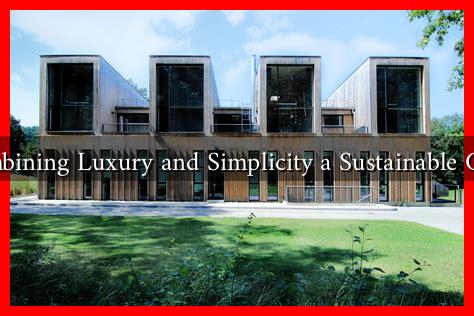-
Table of Contents
- Is Combining Luxury and Simplicity a Sustainable Choice?
- The Essence of Luxury and Simplicity
- Understanding Sustainability in Luxury
- Key Aspects of Sustainable Luxury
- The Role of Simplicity in Sustainable Luxury
- Examples of Brands Merging Luxury and Simplicity
- Challenges in Merging Luxury and Simplicity
- The Future of Luxury and Simplicity
- Conclusion
Is Combining Luxury and Simplicity a Sustainable Choice?
In an era where sustainability is at the forefront of consumer consciousness, the intersection of luxury and simplicity presents a compelling narrative. As brands strive to meet the demands of eco-conscious consumers, the question arises: can luxury and simplicity coexist in a sustainable manner? This article explores the nuances of this relationship, examining how brands can embrace both luxury and simplicity while promoting sustainability.
The Essence of Luxury and Simplicity
Luxury is often associated with opulence, exclusivity, and high-quality materials. In contrast, simplicity emphasizes minimalism, functionality, and a focus on essential elements. The challenge lies in merging these two seemingly opposing concepts into a cohesive and sustainable model.
Understanding Sustainability in Luxury
Sustainability in luxury is not merely a trend; it is becoming a necessity. According to a report by McKinsey, 67% of consumers consider sustainability when making luxury purchases. This shift is prompting luxury brands to rethink their production processes, sourcing, and overall impact on the environment.
Key Aspects of Sustainable Luxury
- Ethical Sourcing: Luxury brands are increasingly focusing on ethically sourced materials, such as organic cotton, recycled metals, and sustainable leather alternatives.
- Transparency: Consumers demand transparency in the supply chain. Brands that openly share their sourcing and production processes build trust and loyalty.
- Longevity: High-quality products that stand the test of time reduce waste and promote a culture of mindful consumption.
The Role of Simplicity in Sustainable Luxury
Simplicity plays a crucial role in promoting sustainability within luxury. By focusing on essential elements, brands can reduce waste and encourage consumers to invest in fewer, high-quality items. This minimalist approach aligns with the principles of sustainable living.
Examples of Brands Merging Luxury and Simplicity
- Everlane: Known for its “Radical Transparency,” Everlane offers luxury basics made from sustainable materials. Their focus on simplicity and ethical production resonates with consumers seeking both quality and sustainability.
- Patagonia: While not traditionally viewed as a luxury brand, Patagonia’s commitment to high-quality outdoor gear and environmental activism exemplifies how simplicity and sustainability can coexist. Their “Worn Wear” program encourages consumers to repair and reuse products.
- Hermès: The luxury brand has embraced sustainability by focusing on craftsmanship and timeless designs. Their products are made to last, reducing the need for frequent replacements.
Challenges in Merging Luxury and Simplicity
While the combination of luxury and simplicity offers numerous benefits, challenges remain. Some of these include:
- Consumer Perception: Luxury consumers may resist the idea of simplicity, associating it with lower quality or exclusivity.
- Cost Implications: Sustainable materials and ethical production often come at a higher cost, which can deter some consumers.
- Market Saturation: As more brands adopt sustainable practices, standing out in a crowded market becomes increasingly difficult.
The Future of Luxury and Simplicity
The future of luxury lies in its ability to adapt to changing consumer values. As sustainability becomes a non-negotiable aspect of purchasing decisions, brands that successfully combine luxury and simplicity will likely thrive. The key is to create products that are not only beautiful and functional but also environmentally responsible.
Conclusion
Combining luxury and simplicity is not only a sustainable choice but also a necessary evolution in the luxury market. As consumers become more aware of their purchasing power, brands must respond by prioritizing ethical practices and minimalism. The successful integration of these elements can lead to a more sustainable future, where luxury is defined not just by opulence but by quality, transparency, and responsibility. In this new paradigm, luxury and simplicity can coexist harmoniously, paving the way for a more sustainable world.
For further insights on sustainable luxury, you can explore resources from organizations like the Sustainable Fashion Forum.


